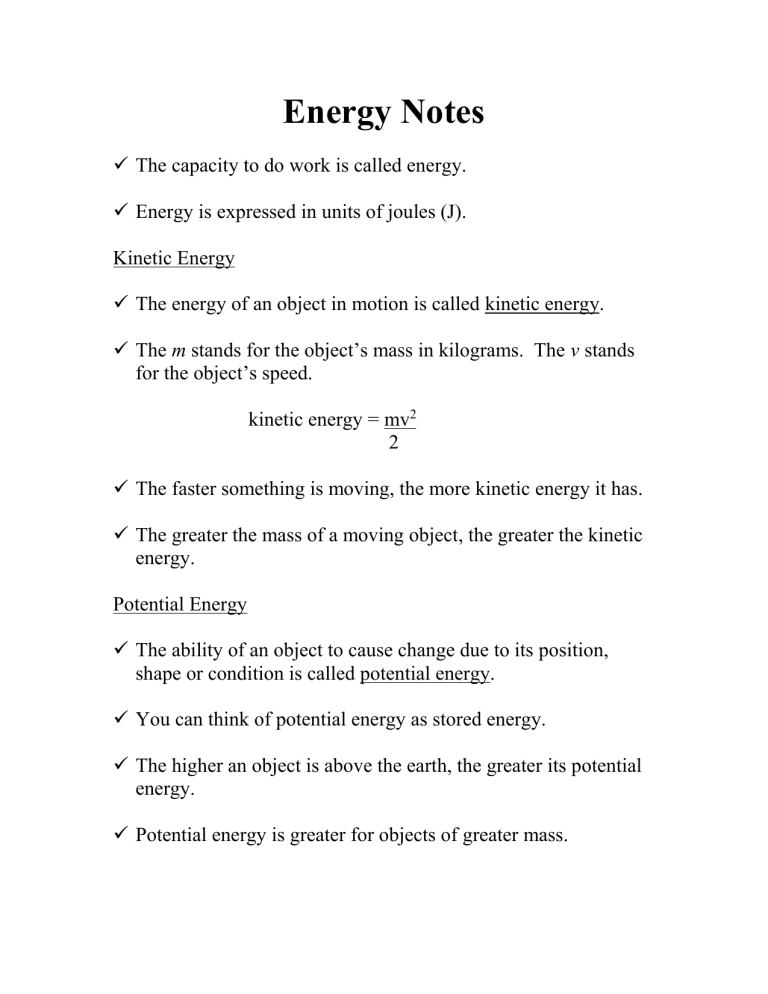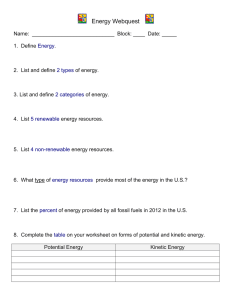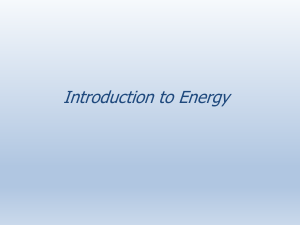
Energy Notes The capacity to do work is called energy. Energy is expressed in units of joules (J). Kinetic Energy The energy of an object in motion is called kinetic energy. The m stands for the object’s mass in kilograms. The v stands for the object’s speed. kinetic energy = mv2 2 The faster something is moving, the more kinetic energy it has. The greater the mass of a moving object, the greater the kinetic energy. Potential Energy The ability of an object to cause change due to its position, shape or condition is called potential energy. You can think of potential energy as stored energy. The higher an object is above the earth, the greater its potential energy. Potential energy is greater for objects of greater mass. The potential energy an object has because of its position above ground is called gravitational potential energy. gravitational potential energy = weight x height Mechanical Energy Kinetic and potential energy are the two forms of what is called mechanical energy. Mechanical energy is energy due to motion or position. mechanical energy = potential energy + kinetic energy Other forms of energy include; thermal, chemical, electrical, sound, light, and nuclear energy. Thermal energy is all of the kinetic energy due to random motion of the particles that make up an object. 1. Particles move faster at higher temperatures 2. The faster the particles move, the greater their kinetic and thermal energies Chemical energy is the energy of a compound that changes as its atoms are rearranged. 1. Chemical energy is a form of potential energy Electrical energy is the energy of moving electrons (negatively charged particles of atoms) Sound energy is caused by an object’s vibrations Light energy is produced by the vibrations of electrically charged particles Nuclear energy comes from changes in the nucleus of an atom Energy Conversion The change of energy from one form to another is called energy conversion. Energy conversion in plants is known as photosynthesis. Conservation of Energy According to the law of conservation of energy, energy cannot be created or destroyed. The total amount of energy in a closed system is always the same. Any time one form of energy is converted into another form, some of the original energy always gets converted into thermal energy due to friction. This energy is not useful. Energy Resources A fossil fuel is a nonrenewable resource formed from the remains of organisms that lived long ago. They are concentrated forms of the sun’s energy. Oil, natural gas, and coal are the most common fossil fuels. Renewable resources are replaced quickly and are considered practically limitless. These include solar energy, energy from the water, wind energy, and geothermal energy.



